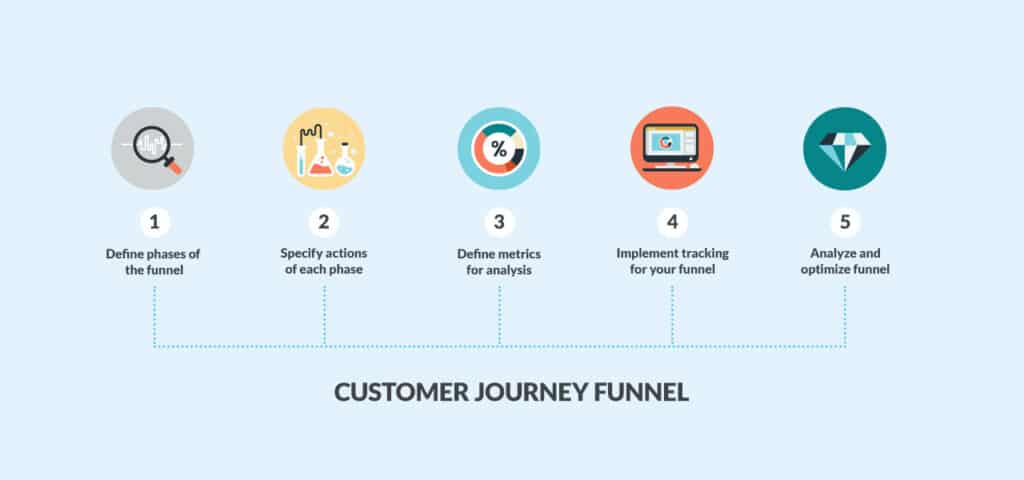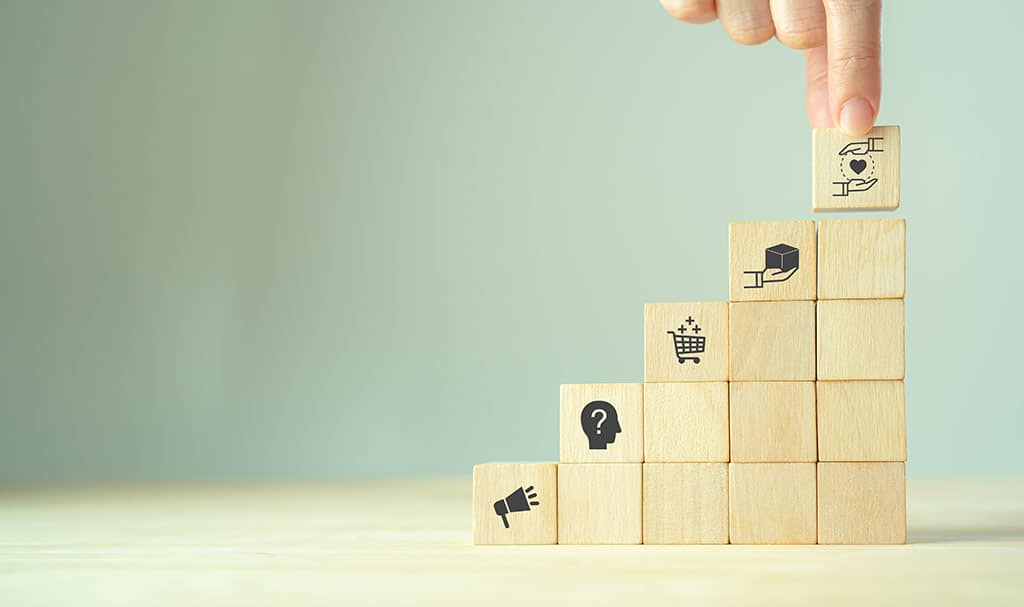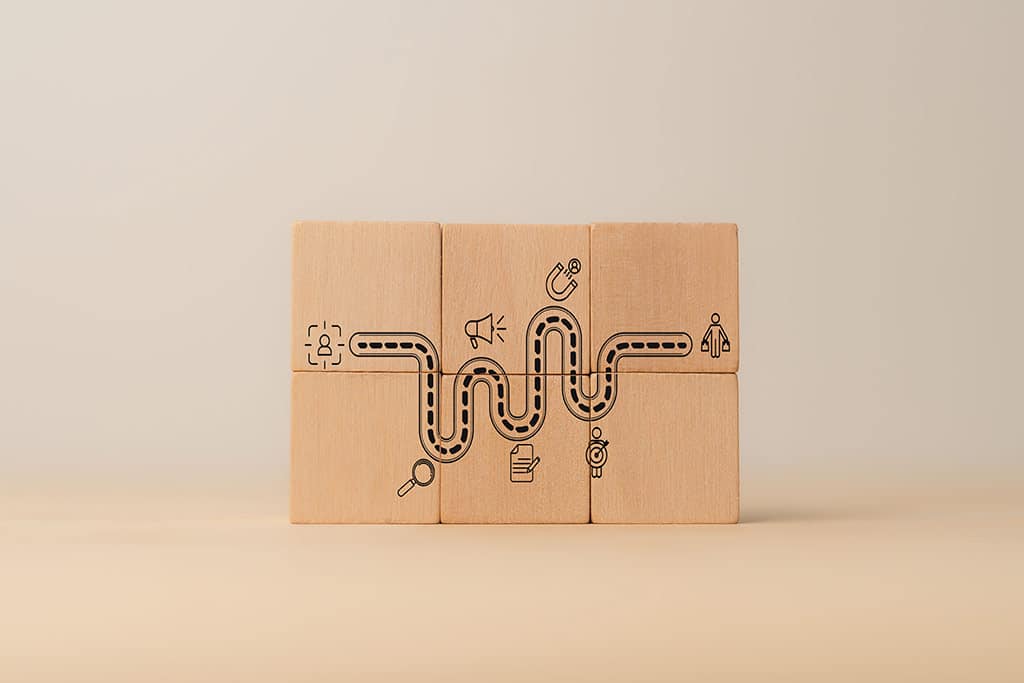
Step 1: Define the phases of your funnel
Defining the phases in a customer journey funnel is the first step in setting it up.
Defining the phases not only provides a structured representation of the entire customer interaction process, but also enables in-depth analysis and optimization of the same.
By clearly defining the phases of your funnel, you can visualize the path that potential customers take from their first encounter with your brand to completing a purchase.
These definitions provide a clear overview of the different stages that customers go through during their interaction with your company. This allows you to specifically address their needs and requirements at each stage and take appropriate measures to optimize interactions.

The definition of phases also supports a consistent and structured approach to managing the customer journey.
It makes it easier to break down the customer journey into easily understandable sections, which simplifies the analysis and management of the entire process.
Examples of typical phases could be
- Awareness
- Interest
- Evaluation
- Purchase
- Commitment
- Recommendation
Step 2: Determine the actions for each phase of the funnel
When designing a customer journey funnel, it is crucial to consider the specific actions that a customer performs in each phase.
This ensures targeted and effective management of customer interactions.
By defining clear action steps at each stage, companies can ensure that customers receive the necessary information, support or incentives to guide them successfully through the funnel.
This strengthens customer loyalty, improves conversion rates and ultimately ensures a positive customer experience.
In addition, defined actions enable personalization of interactions with customers by responding to individual needs and preferences.
This contributes to greater satisfaction and loyalty.
Examples of possible actions:
- Awareness phase: website visits, social media interactions, advertising clicks
- Interest phase: product views, newsletter registration
- Evaluation phase: product comparisons, reading reviews
- Purchase phase: adding products to the shopping cart, completing the purchase
- Engagement phase: product registration, submitting customer reviews
- Recommendation phase: Recommendations to friends, social sharing of content
Step 3: Use metrics for analysis
In the third step, you should carefully select metrics to measure progress in each phase of the funnel.
These metrics are crucial to capture, evaluate and improve the success of your marketing and sales activities.

By using metrics, you can accurately track your customers’ progress through the funnel while identifying bottlenecks or issues.
This allows you to identify specific areas where the customer journey can be improved.
In addition, metrics help you to evaluate the effectiveness of various measures and ensure that resources are used efficiently.
They form the basis for data-driven decision-making and enable you to continuously optimize your customer interactions.
Ultimately, metrics help you deliver an outstanding customer experience and build long-term customer relationships by providing insights and directions for improvement.
Examples of possible metrics:
- Number of website visits
- Conversion rate (for example, from visitors to leads or from leads to customers)
- Average shopping cart value
- Customer reviews or NPS (Net Promoter Score)
Step 4: Implement tracking for your funnel
Tracking in the customer journey funnel gives you the opportunity to track and understand your customers’ behavior throughout their entire journey.
Tracking gives you precise insights into how customers interact with your products, services and marketing messages – from the first touchpoints to the completion of a purchase or transaction.
These insights enable you to identify bottlenecks or obstacles in the customer journey and take targeted measures to improve the customer experience.

Tracking also allows you to continuously optimize the customer journey by evaluating the effectiveness of marketing and sales activities and making appropriate adjustments.
Examples of possible tracking methods:
- Website analytics
- Email tracking
- Social media analytics
- Transaction data
- Customer feedback
Step 5: Analyse and optimize the funnel
The final and crucial step in building an effective customer journey funnel is to analyse and continuously optimize the entire process.
This ensures that you can meet the constantly changing needs and expectations of your customers.
By regularly analyzing the customer journey, you can gain valuable insights into how customers interact with your company and where there is room for improvement.
This analysis allows you to identify bottlenecks or obstacles in the customer journey and take targeted measures to eliminate or minimize them.
This can help to improve the customer experience and increase completion rates.

In addition, the continuous optimization of the customer journey funnel allows you to continuously adapt and improve your marketing and sales strategies.
By evaluating the effectiveness of your activities and integrating insights from the analysis into your decision-making, you can ensure that you can always offer your customers an optimal experience and build long-term customer relationships.
Conclusion
Now you know the necessary steps to build a customer journey funnel.
But why is this important?
Building an effective customer journey funnel is a crucial step in providing customers with an optimal experience and building long-term customer relationships.
The five steps – defining phases, determining action steps, selecting suitable metrics, implementing tracking and analysis and continuous optimization – provide you with a structured approach to improving interactions with your customers and continuously adapting your marketing and sales strategies.
By regularly analyzing and optimizing the customer journey, you can ensure that you can meet the ever-changing needs and expectations of your customers and ensure long-term success in a dynamically evolving business environment.
More about Customer Journey
- Customer Journey: A central component of the customer experience
- Customer journey management: What it is and why you need it
- The 5 phases of a Customer Journey
- Customer Journey Map: The visualization of the customer journey
- 7 steps to a B2B customer journey strategy
- 8 methods for analyzing the customer journey






